Changing Patterns of the Flow Ratio with the Distance of Exhaust and Supply Hood in a Parallel Square Push-Pull Ventilation
Abstract
:1. Introduction
2. Subjects and Methods
2.1. Geometric Models
2.2. Research Conditions
- ρ—gas density, kg/m3. The gas density of air is 1.205 kg/m3 at 20 °C used in this study.
- v—hood face velocity, m/s. See Table 1.
- d—hydraulic diameter, m. It is 0.7 m for the push hood and pull hood in this study.
- η—dynamic viscosity, Pa·s. The dynamic viscosity of air is 1.81 × 10−5 Pa·s at 20 °C used in this study.
3. Results
3.1. Results of the Optimal k Value at Different Distances (L/a)
3.2. Results of the Longest Control Distance (L/a) for Parallel Square Push-Pull Ventilation
3.3. Changing Patterns of k Value with L/a When 1.5 ≤ L/a ≤ 5
4. Discussion
- (1)
- The results of this study are based on the square hood. If the hood is circular or rectangular, it may be estimated by equivalent diameter according to the results in Reference [1] and modified appropriately.
- (2)
- There is a worktable between the push and pull hood without flange. If a change is found in the model, the results of the study should be applied with appropriate modifications.
- (3)
- This study does not consider the influence of disturbing the air flow, but it may exist in practice. The size and position of contaminants in practice may have some deviation from the model in this study. Therefore, the results of this study should be applied with appropriate modifications in those above cases.
5. Conclusions
- (1)
- When L/a is 6 or more, a parallel push-pull ventilation is not suitable for use.
- (2)
- The relationship between k and L/a for a parallel push-pull ventilation can be expressed in the equation of k = 0.1675(L/a)3 − 1.318(L/a)2 + 3.6085(L/a) − 1.5352, when 1.5 ≤ L/a ≤ 5.0.
- (3)
- If L/a is known, a relatively accurate k value can be determined by using Equation (3), presented in this study, which can be used in the design of a parallel push-pull ventilation system. When the actual situation and the conditions of this study are different, the appropriate amendments should be made.
Funding
Institutional Review Board Statement
Informed Consent Statement
Data Availability Statement
Conflicts of Interest
References
- Chen, J. Research on the axial velocity change rule of desktop slot exhaust hood. Ind. Health 2018, 56, 278–284. [Google Scholar] [CrossRef] [PubMed] [Green Version]
- Chen, J.; Sun, Y.; Zhang, X.; Chen, Z.; Liu, W. Study on the Upper Flange Width on Grinding Worktable and Its Ergonomics Evaluation. In Proceedings of the Man–Machine–Environment System Engineering, MMESE 2019, Shanghai, China, 19–21 October 2019; Lecture Notes in Electrical Engineering. Long, S., Dhillon, B.S., Eds.; Springer: Singapore, 2020; Volume 800, pp. 827–835. [Google Scholar] [CrossRef]
- Huebener, D.J.; Hughes, R.T. Development of Push pull Ventilation. Am. Ind. Hyg. Assoc. J. 1985, 46, 262–267. [Google Scholar] [CrossRef] [PubMed]
- Guo, P.; Fu, H.; Zhao, Y.; Li, Y. Development and present status of push pull ventilation technology. Heat Vent. Air Cond. 2008, 38, 57–61. [Google Scholar]
- Hughes, R.T. An overview of push pull ventilation characteristics. Appl. Occup. Environ. Hyg. 1990, 5, 156–161. [Google Scholar] [CrossRef]
- Wang, Y.; Quan, M.; Zhou, Y. Effect of velocity non-uniformity of supply air on the mixing characteristics of push pull ventilation systems. Energy 2019, 187, 115962. [Google Scholar] [CrossRef]
- Yang, B.; Chen, J.; Liu, L.; Sun, Y.; Liu, W. Numerical Simulation Research on Design of Displacement Ventilation System in Large Painting Workshop. In Proceedings of the Man-Machine-Environment System Engineering, MMESE 2020, Zhengzhou, China, 24–26 October 2020; Lecture Notes in Electrical Engineering. Long, S., Dhillon, B.S., Eds.; Springer: Singapore, 2020; Volume 645, pp. 369–377. [Google Scholar] [CrossRef]
- Chen, J.; Yang, Z.; Yang, B.; Sun, Y.; Liu, L.; Xiao, M. Study on Toxic Control Technology of Combined Ventilation for Internal Painting of Large Work Pieces. In Proceedings of the Man-Machine-Environment System Engineering, 21st International Conference on MMESE. MMESE 2021, Beijing, China, 23–25 October 2021; Lecture Notes in Electrical Engineering. Long, S., Dhillon, B.S., Eds.; Springer: Singapore, 2022; Volume 800, pp. 488–495. [Google Scholar] [CrossRef]
- Leung, M.; Chun-Ho Liu, C.; Alan, H.S.; Chan, A. Occupational Exposure to Volatile Organic Compounds and Mitigation by Push pull Local Exhaust Ventilation in Printing Plants. J. Occup. Health 2005, 47, 540–547. [Google Scholar] [CrossRef] [PubMed] [Green Version]
- Yang, B.; Chen, J.; Liang, S.; Zhou, S.; Li, Y. Design and Application of a Ventilation System in a Washing Board Room Based on Numerical Simulation. In Proceedings of the Man–Machine–Environment System Engineering, MMESE 2019, Shanghai, China, 19–21 October 2019; Lecture Notes in Electrical Engineering. Long, S., Dhillon, B.S., Eds.; Springer: Singapore, 2020; Volume 576, pp. 469–475. [Google Scholar] [CrossRef]
- Liang, S.; Chen, J.; Yang, B.; Lin, M.; Liu, L.; Zhang, T. Research on Ventilation Antivirus Technology in a Washing Board Room Based on Numerical Simulation. In Proceedings of the Man–Machine–Environment System Engineering, MMESE 2017, Jian, China, 21–23 October 2017; Lecture Notes in Electrical Engineering. Long, S., Dhillon, B.S., Eds.; Springer: Singapore, 2018; Volume 456, pp. 487–494. [Google Scholar] [CrossRef]
- Iwasaki, T.; Fujishiro, Y.; Kubota, Y.; Ojima, J.; Shibata, N. Some Engineering Countermeasures to Reduce Exposure to Welding Fumes and Gases Avoiding Occurrence of Blow Holes in Welded Material. Ind. Health 2005, 43, 351–357. [Google Scholar] [CrossRef] [PubMed] [Green Version]
- Masanori Ogawa, M.; Kabe, I.; Terauchi, Y.; Shigeru Tanaka, S. A strategy for the reduction of formaldehyde concentration in a hospital pathology laboratory. J. Occup. Health 2019, 61, 135–142. [Google Scholar] [CrossRef] [PubMed]
- Wu, X.; Liu, L.; Luo, X.; Chen, J.; Dai, J. Study on Flow Field Characteristics of the 90 Rectangular Elbow in the Exhaust Hood of a Uniform Push-pull Ventilation Device. Int. J. Environ. Res. Public Health 2018, 15, 2884. [Google Scholar] [CrossRef] [PubMed] [Green Version]
- Chen, J.; Bai, Y.; Yang, B.; Liu, L.; Liu, W. Research on the Uniform Air Supply Technology of the Static Pressure Chamber in a Spray Room. In Proceedings of the Man–Machine–Environment System Engineering, MMESE 2020, Zhengzhou, China, 24–26 October 2020; Lecture Notes in Electrical Engineering. Long, S., Dhillon, B.S., Eds.; Springer: Singapore, 2020; Volume 645, pp. 589–596. [Google Scholar] [CrossRef]
- Chen, J.; Yang, B.; Liang, S.; Chen, Z.; Sun, Y.; Zhang, T. Study on the Performances of Supply Air for Uniform Air Supply Square Hood by Numerical Simulation. In Proceedings of the Man–Machine–Environment System Engineering, MMESE 2017, Jian, China, 21–23 October 2021; Lecture Notes in Electrical Engineering. Long, S., Dhillon, B.S., Eds.; Springer: Singapore, 2018; Volume 456, pp. 449–455. [Google Scholar] [CrossRef]
- Chen, J.; Jin, L.; Chen, Z.; Yang, B.; Zhou, S. Center-Line Velocity Change Regime in a Parallel-Flow Square Exhaust Hood. Int. J. Environ. Res. Public Health 2020, 17, 4485. [Google Scholar] [CrossRef] [PubMed]
- Wang, Y.; Zhou, Y.; Yang, Y.; Wu, S.; Zhang, X.; Ren, X. Movement and control of evaporating droplets released from an open surface tank in the push-pull ventilation system. Build. Simul. 2016, 9, 443–457. [Google Scholar] [CrossRef]
- Wang, Y.; Quan, M.; Zhou, Y.; Cao, Y.; Xie, C.; Li, L. Experimental study on the flow field and economic characteristics of parallel push pull ventilation system. Energy Built Environ. 2020, 1, 393–403. [Google Scholar] [CrossRef]
- Iwazaki, T.; Okamura, Y.; Numano, K.; Aoyagi, K. Standard Design and Maintenance of Local Exhaust Push Pull Ventilation System and Air Cleaner; Japan Central Labor Disaster Prevention Association: Tokyo, Japan, 2013; pp. 125–136. [Google Scholar]
- Liu, L.; Dai, J.; Yang, J.; Jin, M.; Jiang, W.; Lu, X. Intelligent simulation experimental study on influence of air velocity of air supply hood and exhaust hood with vertical push pull ventilation. J. Intell. Fuzzy Syst. 2019, 37, 4819–4826. [Google Scholar] [CrossRef]
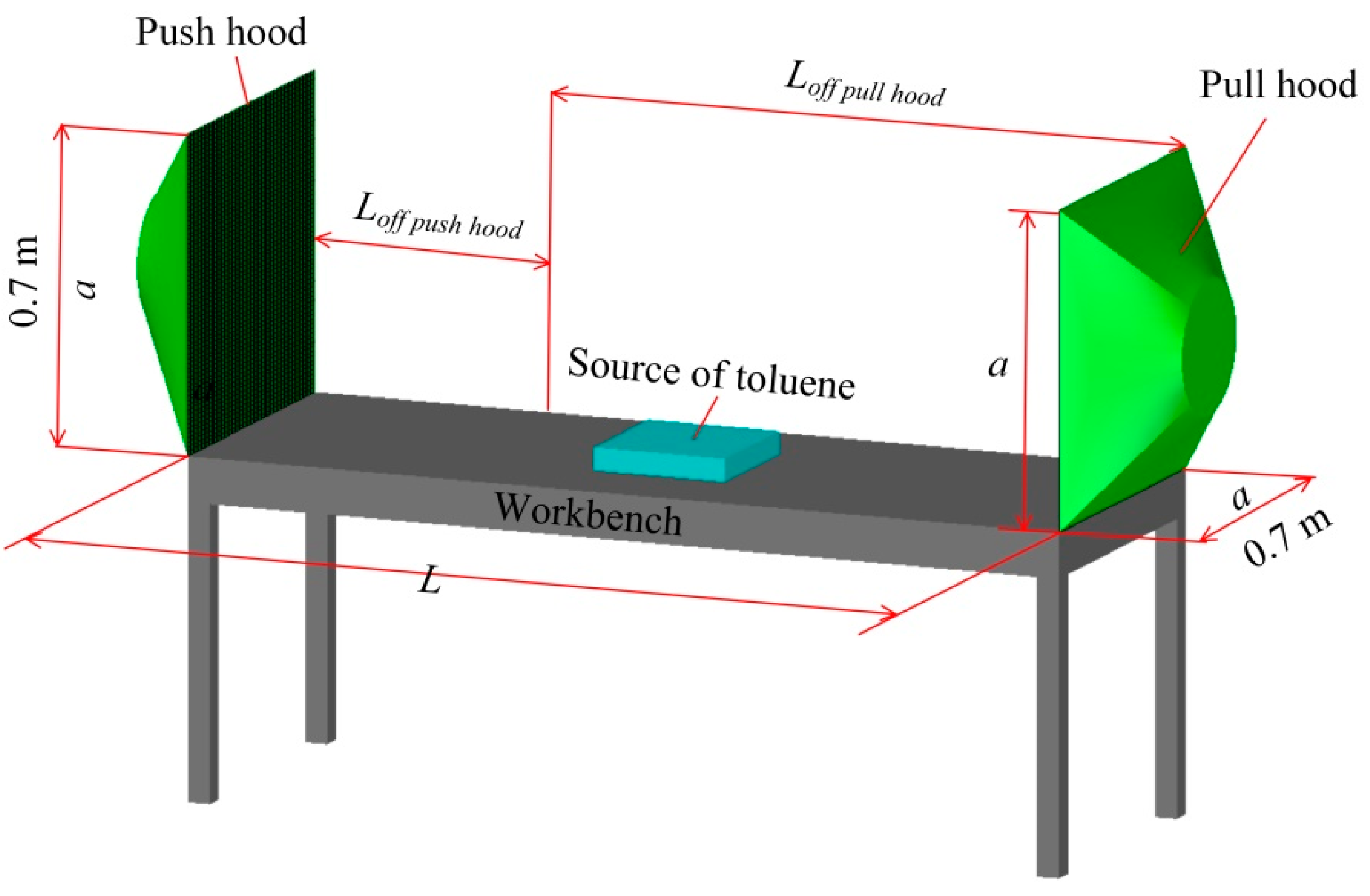
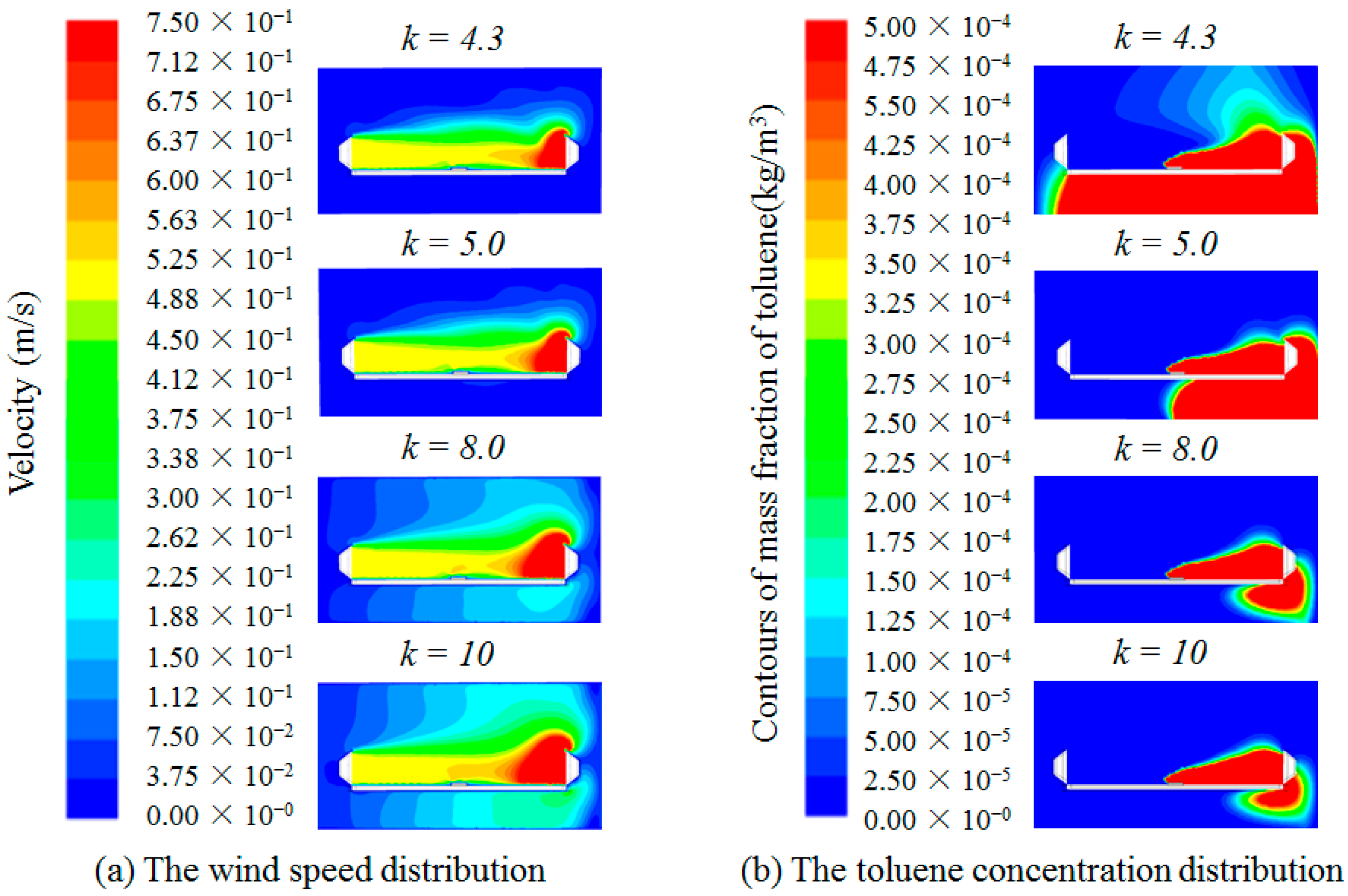
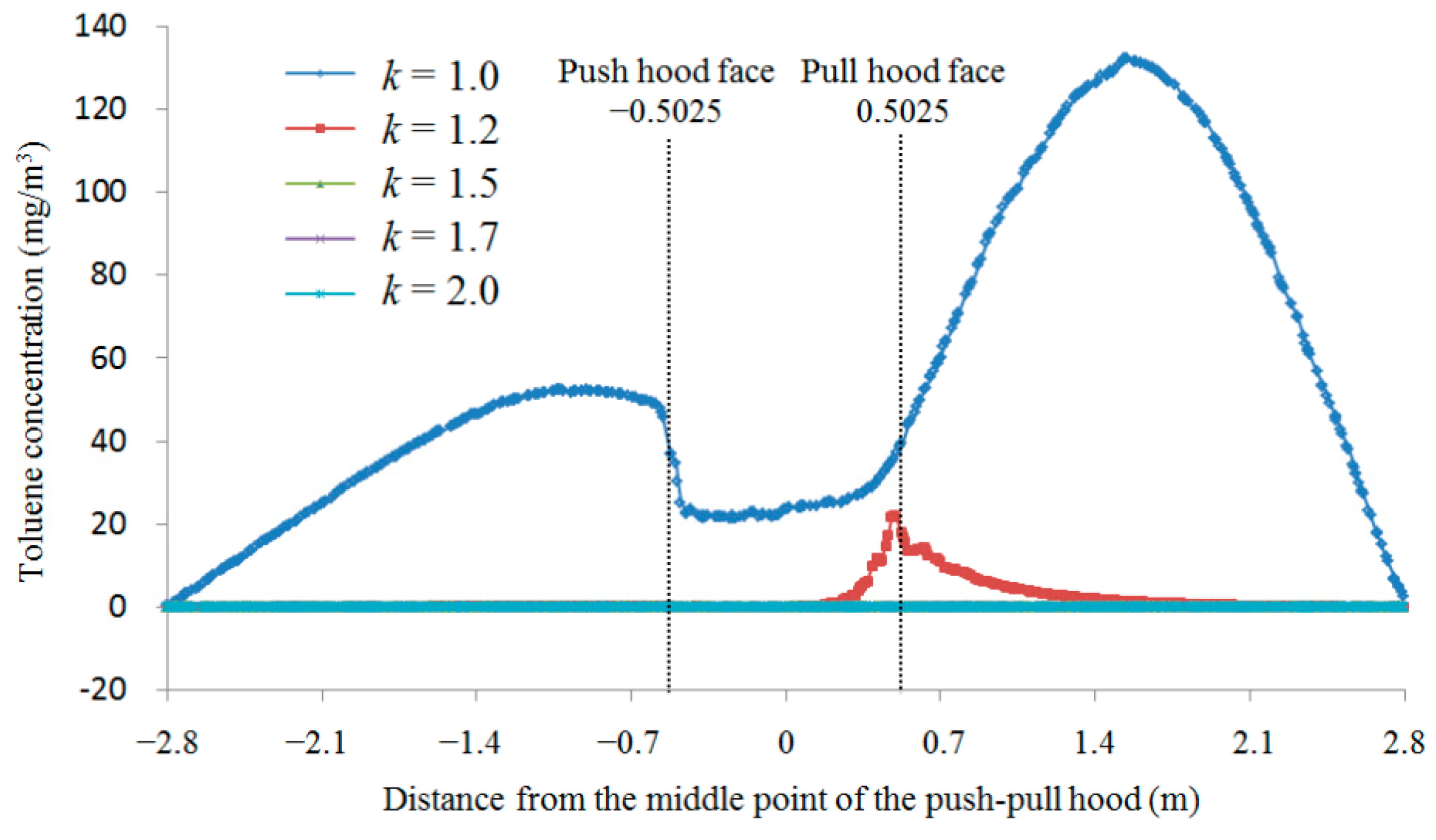

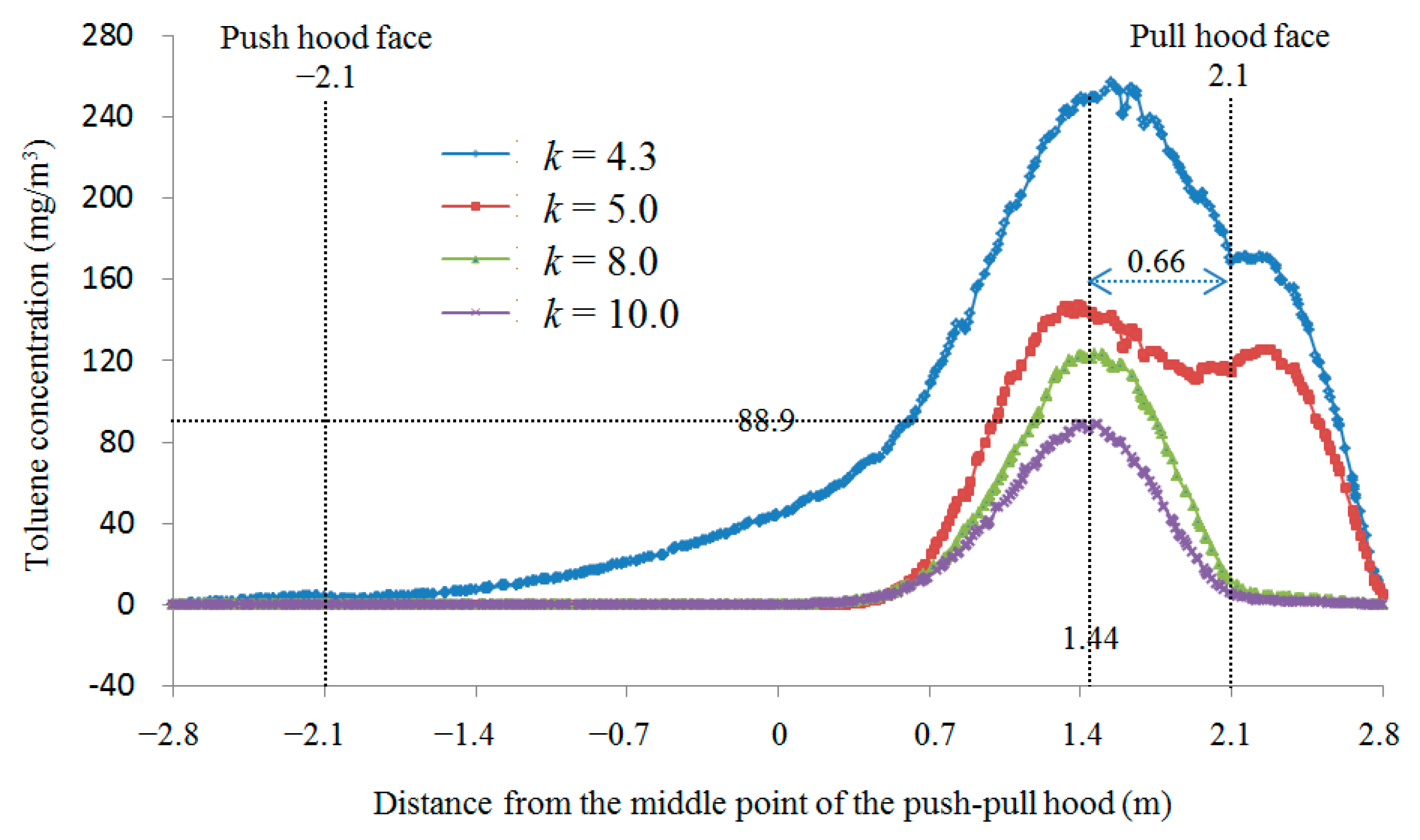
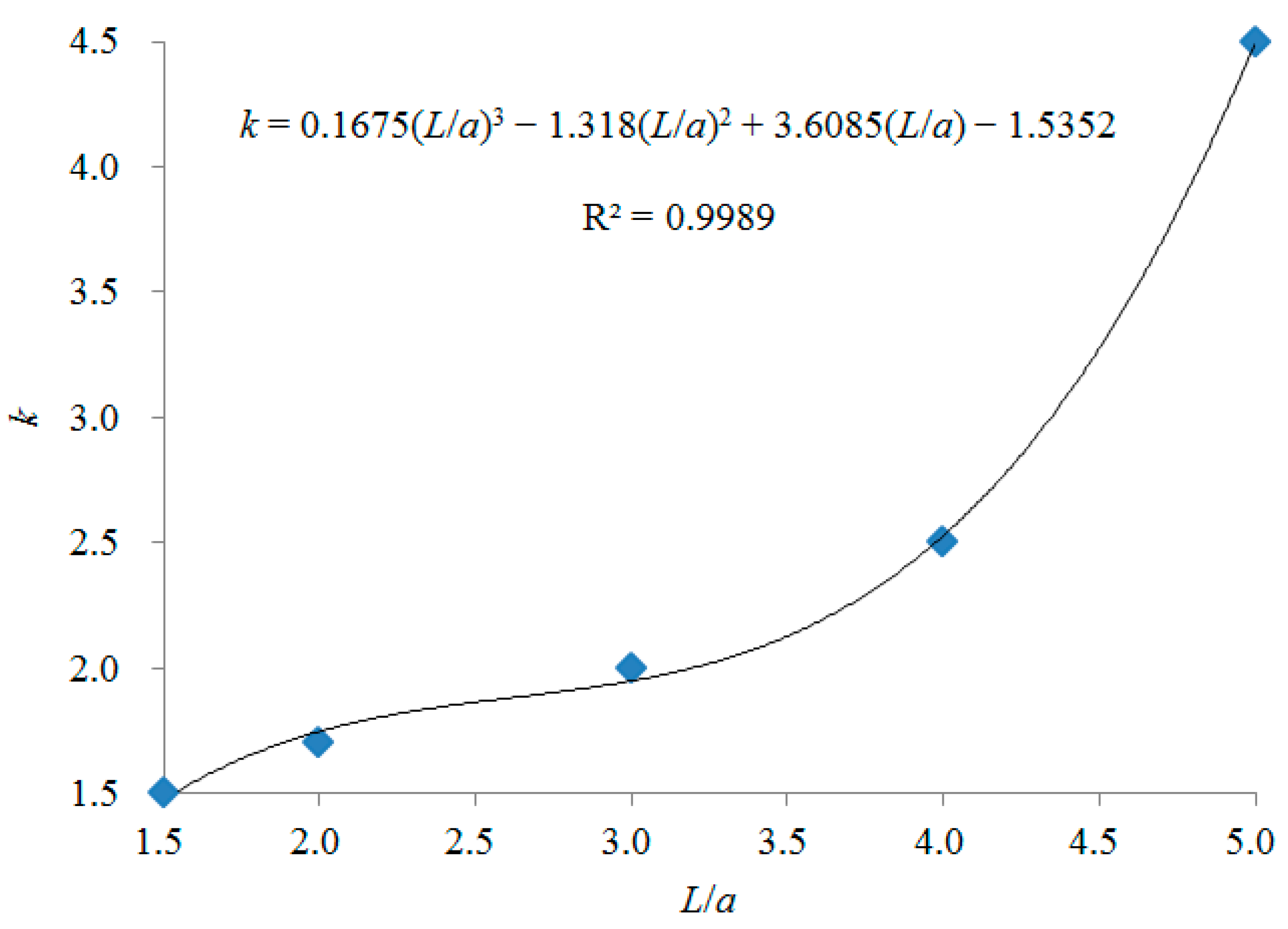
| Push Hood Face Velocity (v1, m/s) | Flow Ratio (k) | Pull Hood Face Velocity (v2, m/s) | Turbulence Intensityof Outlet (I, %) | Reynolds Number of Outlet (Re) |
|---|---|---|---|---|
| 0.50 | 1.0 | 0.50 | 4.55% | 2.33 × 104 |
| 0.50 | 1.2 | 0.60 | 4.45% | 2.80 × 104 |
| 0.50 | 1.5 | 0.75 | 4.33% | 3.50 × 104 |
| 0.50 | 1.7 | 0.85 | 4.26% | 3.96 × 104 |
| 0.50 | 2.0 | 1.00 | 4.17% | 4.66 × 104 |
| 0.50 | 2.2 | 1.10 | 4.12% | 5.13 × 104 |
| 0.50 | 2.3 | 1.15 | 4.10% | 5.36 × 104 |
| 0.50 | 2.5 | 1.25 | 4.06% | 5.83 × 104 |
| 0.50 | 2.7 | 1.35 | 4.02% | 6.29 × 104 |
| 0.50 | 3.0 | 1.50 | 3.97% | 6.99 × 104 |
| 0.50 | 3.1 | 1.55 | 3.95% | 7.22 × 104 |
| 0.50 | 3.6 | 1.80 | 3.88% | 8.39 × 104 |
| 0.50 | 4.0 | 2.00 | 3.83% | 9.32 × 104 |
| 0.50 | 4.3 | 2.15 | 3.79% | 1.00 × 105 |
| 0.50 | 4.5 | 2.25 | 3.77% | 1.05 × 105 |
| 0.50 | 5.0 | 2.50 | 3.72% | 1.17 × 105 |
| 0.50 | 8.0 | 4.00 | 3.51% | 1.86 × 105 |
| 0.50 | 10.0 | 5.00 | 3.41% | 2.33 × 105 |
| Boundary Conditions | Define |
|---|---|
| Inlet | Push hood face |
| Inlet boundary type | Velocity-inlet |
| Velocity inlet (m/s) | 0.5 |
| Material | air |
| Air viscosity (kg/(m·s)) | 1.81 × 10−5 |
| Hydraulic diameter of inlet (m) | 0.7 |
| Turbulence intensity of inlet (%) | 4.55 |
| Outlet | Pull hood face |
| Outlet boundary type | Velocity-inlet |
| Velocity outlet (m/s) | See Table 1 |
| Turbulence intensity of outlet (%) | See Table 1 |
| Species mass fractions | C7H8 0.9 |
| Mass flow rate (mg/s) | 500 |
| Species transport | On |
| Solver type | Pressure-based |
| Solver velocity formulation | Absolute |
| Solver time | Steady |
| Viscous model | standard k-ε |
| Energy | On |
| Pressure-velocity coupling scheme | SIMPLEC |
| Discrete format | Second order upwind |
| Convergence criterion | 10−6 |
| Interaction to plot and store | 1000 |
| No. | L/a | k Value Research Range | Optimal k Value |
|---|---|---|---|
| 1 | 1.5 | 1.0, 1.2, 1.5, 1.7, 2.0 | 1.5 |
| 2 | 2.0 | 1.0, 1.5, 1.7, 2.0, 3.0 | 1.7 |
| 3 | 3.0 | 1.5, 1.7, 1.9, 2.0, 2.3, 2.7 | 2.0 |
| 4 | 4.0 | 1.5, 2.2, 2.3, 2.5, 2.7, 3.0 | 2.5 |
| 5 | 5.0 | 2.7, 3.1, 3.6, 4.0, 4.5, 5.0 | 4.5 |
Publisher’s Note: MDPI stays neutral with regard to jurisdictional claims in published maps and institutional affiliations. |
© 2022 by the author. Licensee MDPI, Basel, Switzerland. This article is an open access article distributed under the terms and conditions of the Creative Commons Attribution (CC BY) license (https://creativecommons.org/licenses/by/4.0/).
Share and Cite
Chen, J. Changing Patterns of the Flow Ratio with the Distance of Exhaust and Supply Hood in a Parallel Square Push-Pull Ventilation. Int. J. Environ. Res. Public Health 2022, 19, 2957. https://doi.org/10.3390/ijerph19052957
Chen J. Changing Patterns of the Flow Ratio with the Distance of Exhaust and Supply Hood in a Parallel Square Push-Pull Ventilation. International Journal of Environmental Research and Public Health. 2022; 19(5):2957. https://doi.org/10.3390/ijerph19052957
Chicago/Turabian StyleChen, Jianwu. 2022. "Changing Patterns of the Flow Ratio with the Distance of Exhaust and Supply Hood in a Parallel Square Push-Pull Ventilation" International Journal of Environmental Research and Public Health 19, no. 5: 2957. https://doi.org/10.3390/ijerph19052957
APA StyleChen, J. (2022). Changing Patterns of the Flow Ratio with the Distance of Exhaust and Supply Hood in a Parallel Square Push-Pull Ventilation. International Journal of Environmental Research and Public Health, 19(5), 2957. https://doi.org/10.3390/ijerph19052957






